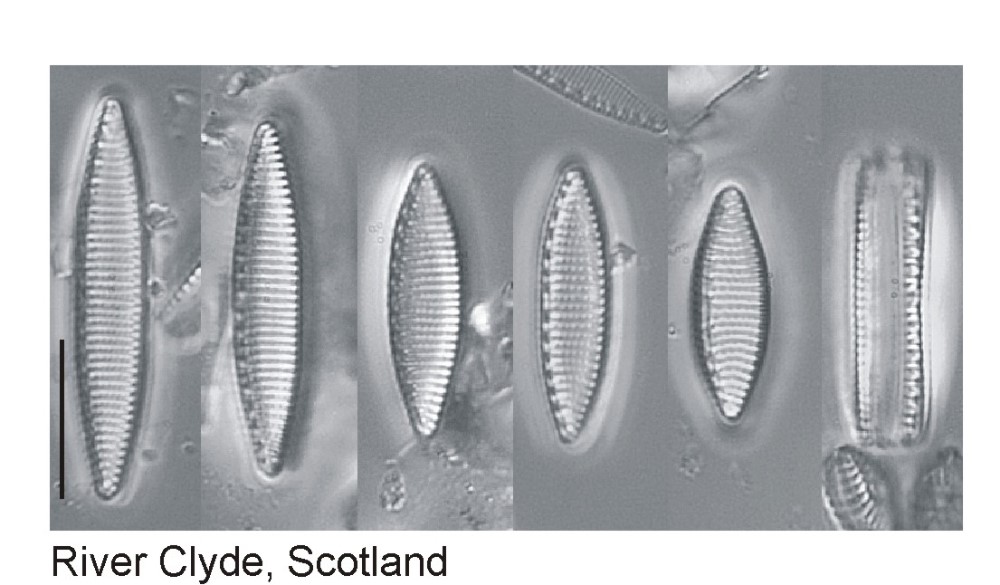Nitzschia amphibia Grunow; 1862; 574
Key references
Krammer K., Lange-Bertalot H. 1988. Süßwasserflora Mitteleuropas. Bacillariophyceae. 2. Teil. Bacillariophyceae, Epithemiaceae, Surirellaceae. Eds. Ettl H., Gerloff J., Heynig H., Mollenhauer D., Gustav Fischer Verlag, Stuttgart. 596 pp
Morphology
Shape
Valves linear-lanceolate to lanceolate (in small cells); the central part of the valve sometimes has very slightly concave margins; valve ends usually slightly rostrate, but sometimes also cuneate.
Symmetry
Isopolar, bilaterally symmetrical.
Striae
Distinct and punctate, 13-18 in 10 µm.
Raphe
Not visible in LM; central raphe endings are present and can be detected with care by a tiny pimple-like thickening of the margin.
Raphe systems of the two valves lie on opposite sides ('nitzschioid symmetry').
Other features
Fibulae prominent. Some fibulae are single structures borne on a transapical rib (virga); others are formed by fusion of two or three extensions of the transapical ribs. They are sometimes extended slightly across the valve along the ribs that bear them, but never by more than c. one-quarter or one-third of the valve width. Central pair of fibulae sometimes but not always more widely separated than the others; 7-9 in 10 µm.
Two chloroplasts per cell, one towards each pole. Each chloroplast is a simple plate, which lies against one valve and one side of the girdle. The cytoplasm is sometimes highly granular and 'sparkly'.
Valves linear-lanceolate to lanceolate (in small cells); the central part of the valve sometimes has very slightly concave margins; valve ends usually slightly rostrate, but sometimes also cuneate.
Symmetry
Isopolar, bilaterally symmetrical.
Striae
Distinct and punctate, 13-18 in 10 µm.
Raphe
Not visible in LM; central raphe endings are present and can be detected with care by a tiny pimple-like thickening of the margin.
Raphe systems of the two valves lie on opposite sides ('nitzschioid symmetry').
Other features
Fibulae prominent. Some fibulae are single structures borne on a transapical rib (virga); others are formed by fusion of two or three extensions of the transapical ribs. They are sometimes extended slightly across the valve along the ribs that bear them, but never by more than c. one-quarter or one-third of the valve width. Central pair of fibulae sometimes but not always more widely separated than the others; 7-9 in 10 µm.
Two chloroplasts per cell, one towards each pole. Each chloroplast is a simple plate, which lies against one valve and one side of the girdle. The cytoplasm is sometimes highly granular and 'sparkly'.
Literature
References are given in chronological order.
Reference |
Citation |
|---|---|
| Grunow A. 1862. Die österreichischen Diatomaceen nebst Anschluss einiger neuen Arten von andern Lokalitäten und einer kritischen Uebersicht der bisher bekannten Gattungen und Arten. Erste Folge. Epithemieae, Meridioneae, Diatomeae, Entopyleae, Surirelleae, Amphipleureae. Zweite Folge. Familie Nitzschieae. 12. Verhandlungen der Kaiserlich-Königlichen Zoologisch-Botanischen Gesellschaft in Wien. 315-472, 545-588 pp; 7 pls. | Morphology; Taxonomy; Description; Illustrations |
| Krammer K., Lange-Bertalot H. 1988. Süßwasserflora Mitteleuropas. Bacillariophyceae. 2. Teil. Bacillariophyceae, Epithemiaceae, Surirellaceae. Eds. Ettl H., Gerloff J., Heynig H., Mollenhauer D., Gustav Fischer Verlag, Stuttgart. 596 pp | Morphology; Illustrations; Ecology; |
This page should be cited as:
Mann D. G., Jüttner I. Nitzschia amphibia Grunow; 1862; 574. In: Jüttner I., Carter C., Cox E.J., Ector L., Jones V., Kelly M.G., Kennedy B., Mann D.G., Turner J. A., Van de Vijver B., Wetzel C.E., Williams D.M..
Freshwater Diatom Flora of Britain and Ireland. Amgueddfa Cymru - National Museum Wales. Available online at https://naturalhistory.museumwales.ac.uk/diatoms/browsespecies.php?-recid=2960. [Accessed:
].
Record last modified: 27/12/2020



